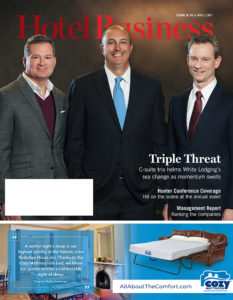Editor’s note: Hotel Business, in partnership with CHMWarnick, sets out to debunk common myths within our industry in the Truth Trackers series. Our chief investigators, Richard Warnick, managing director/co-chairman; Chad Crandell, managing director/CEO; and Ken Wilson, managing director/co-chairman, are on the case to field each myth and shed some light on what is false and what is fact. We have quite a few myths to bust, but would also like to hear from you. If you have a “truth” that you want us to track, our three investigators and their team of hotel experts are on it. You can email me at [email protected]
Myth: Discounting rates to induce trial is a prudent strategy for new hotels.
Truth: Otherwise known as the “Introductory Rate Debate,” this strategy is widely practiced by operators—both branded and independent. Indeed, the practice is so prevalent that it resembles a reflexive response—like what happens when a doctor taps your knee with the rubber hammer. But is it the right—or necessary—thing to do? The natural tendency for owners is to follow their operator’s recommendation on introductory rate strategies. However, not all operators have the same degree of experience in opening new hotels, and even if they do, the strategies surrounding operational ramp-up vary considerably in terms of market dynamics and product specifics. The importance of these pricing decisions cannot be overstated, as they have a material impact on both short- and long-term financial performance. And, while ownership financial goals are clearly outlined by the pro forma, the path to achieve these goals in the opening year is often fuzzy. Misguided discounting can have a long-lasting impact on rate potential that is far more challenging to overcome and detrimental to bottom-line profitability than an early sacrifice in occupancy. Here’s why: (1) You only have one chance to make a first impression, and pricing strategy sets the public expectation of quality, service and experience (“implied market positioning”); (2) Discounting often has the effect of attracting the wrong guests—meaning those who can’t or won’t patronize the hotel when pricing normalizes; and (3) Most importantly, preserving rate integrity from the onset is a lot easier than correcting it mid-stream; that is, once you tell the market that you are worth x, it’s very hard to tell your customer a year later, “Just kidding… We meant 2x.”
We have witnessed firsthand the success that a pro-rate strategy can bring to a new hotel, as well as the aftermath of discounting and the long road to recovery. In two recent examples, operating teams were challenged during the pre-opening period to establish pricing based on their targeted position in the market, ascribing value to their brand-new product and competitive advantages. In both instances, the hotels achieved meaningful ADR premiums above and beyond that in ownership’s pro forma. This rate-centric approach resulted in a modest decline in projected first-year occupancy, but delivered a significantly higher rooms profit and firmly established an elevated position for each hotel in their respective markets. Opening-year transient rates were 5- 10% above and beyond what was originally projected, which, in turn, also supported higher group ADRs. This strategy was not the initial plan outlined by the operating teams. By comparison, we were introduced to another hotel that had been open for a couple of months and was heavily discounting rate in an effort to build occupancy. Although this strategy was only in place for a few short months, it had negatively impacted the profit outlook for the entire year, and required a significant effort to “right the ship.”

